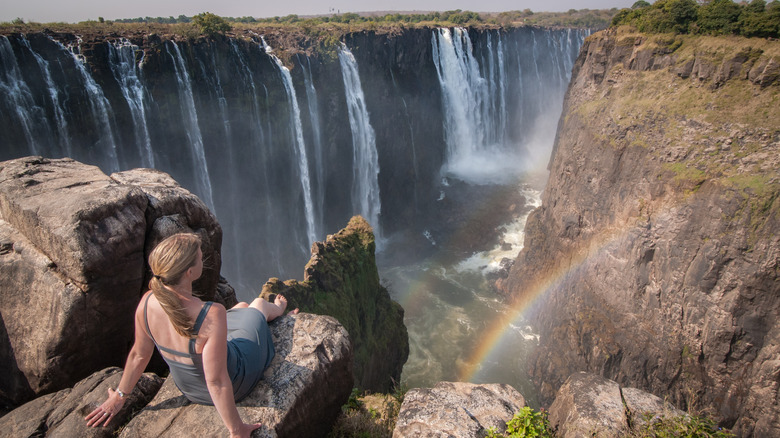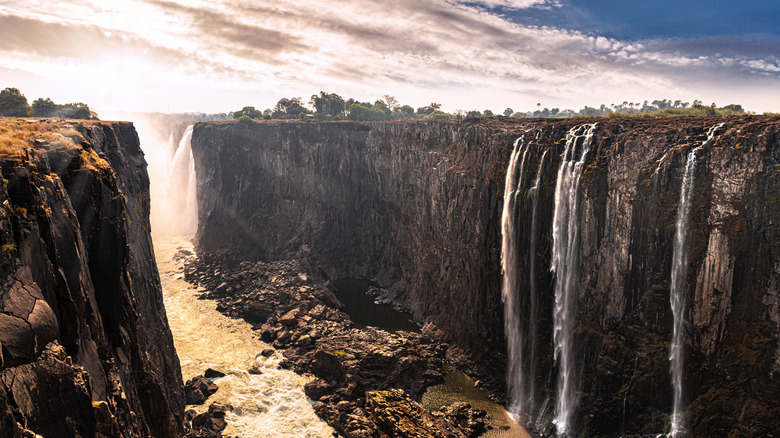Visit One Of The Largest Waterfalls In The World At These Two National Parks In Africa
At the heart of Southern Africa, one of the world's seven natural wonders awaits. This colossal cascade of water, locally known as "The Smoke that Thunders" (Mosi-oa-Tunya), is at the border of Zimbabwe and Zambia, and is definitely a bucket list travel destination. As a UNESCO World Heritage Site,the falls are protected by both Zimbabwe's Victoria Falls National Park and the neighboring Mosi-oa-Tunya National Park in Zambia. With a width of just over one mile and a height of 354 feet, Victoria Falls also has the title of the world's largest sheet of falling water
Victoria Falls National Park spans nearly nine square miles and offers visitors an opportunity to explore stunning landscapes and diverse wildlife in addition to the falls. While Mosi-oa-Tunya is larger (at around 25 square miles), Victoria Falls is well-connected and relatively easy to access from either park. The primary entry points are Victoria Falls town in Zimbabwe and Livingstone in Zambia.
Both cities have international airports and offer various accommodation options, from luxury lodges to budget-friendly hotels. Whether you're planning on visiting one or both parks, checking visa requirements and any border crossing regulations before your visit is advisable, as regulations can vary depending on your nationality. For example, Category B countries like the United States and the United Kingdom must pay visa fees between $30 and $90 to enter Zimbabwe. Citizens of certain countries are required to apply for visas before traveling.
Viewpoints in Victoria Falls National Park
Four of the five main falls are in Victoria Falls National Park in Zimbabwe — including Main Falls, Devil's Cataract, Rainbow, and Horseshoe Falls. Most of the vantage points of the five main falls are in Victoria Falls National Park. Visiting the park from February to May, when the water flow is at its highest, will give the best views at each point.
The west side of Victoria Falls National Park provides the first two striking viewpoints: the Livingstone Statue and Devil's Cataract. The Livingstone Statue is a tribute to the explorer David Livingstone, one of the first Europeans to set eyes on this natural wonder. The Devil's Cataract, the smallest of the five falls, is located on the far west side of the Zimbabwean bank and is most visible from points one through five in the western Victoria Falls National Park.
Viewpoints six through nine in Victoria Falls are dedicated to the eastern portion of the Devil's Cataract, Cataract Island, and the Main Falls, the site's largest fall, dropping 354 feet. The Devil's Pool is located on the Zambia side but can be viewed from viewpoint ten across the falls. Viewpoints 11 through 13 show off Horseshoe Falls, and the highest fall in the park, Rainbow Falls, is visible from viewpoints 14 and 15. The park's 16th and final viewpoint will lead to views of the Victoria Falls Bridge, a famous spot for bungee jumping and bridge swings.
Victoria Falls from Mosi-oa-Tunya
Mosi-oa-Tunya National Park offers a different, lower perspective of the magnificent Victoria Falls. The viewpoints here only showcase around a quarter of the falls, but allow visitors to get closer to the action. The Eastern Cataract is the fifth fall but is the second tallest at 331 feet and can be accessed from the park, providing a closer and more intimate experience with the falls.
In Mosi-oa-Tunya, the Knife's Edge Path offers a thrilling perspective with a walk along the edge of the falls. Viewing the gorge from the Knife's Edge gives park-goers a real understanding of its depth and the power of the falls. To view the falls from below, visitors can hike down to the Boiling Pot from the entrance of Mosi-oa-Tunya. The Boiling Pot is the point where the calm waters of the Zambezi River turn, carving out a pool as it continues its journey through the river's second gorge.
The park also gives the opportunity to visit Livingstone Island and Devil's Pool. During the dry months of October to December, portions on this side of the falls dry up, providing a unique experience of walking on the river bed and exploring the intricate rock formations. If you're visiting to see the rushing water, stick to the viewpoints in Victoria Falls National Park. But if it's wildlife sighting that you're after, the best time to visit Africa is during the dry season in Mosi-oa-Tunya.


